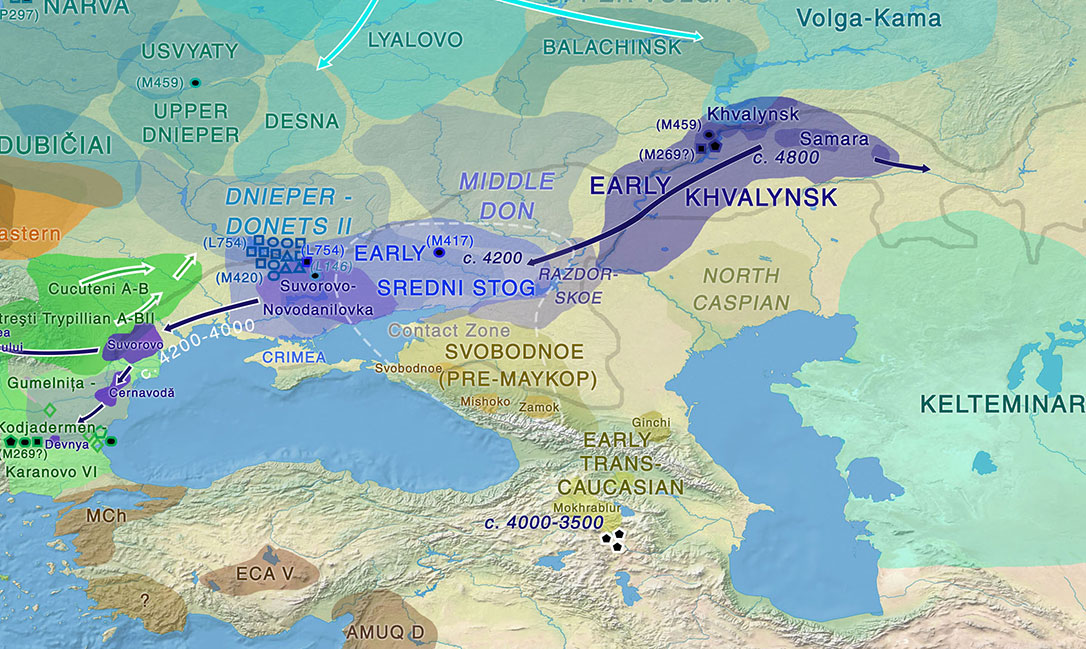Interesting paper Excavation at the Razdolnoe site on the Kalmius river in 2010, by N. Kotova, D. Anthony, D. Brown, S. Degermendzhy, P. Crabtree, In: Archaeology and Palaeoecology of the Ukrainian Steppe / IA NAS of Ukraine, Kyiv 2017.
Nothing new probably to those who have read Anthony (2007), but this new publication of his research on the North Pontic region seems to contradict recent papers which cast doubts on the presence of early forms of domestication in the North Pontic steppe, and would reject thus also the arrival of domestication to Khvalynsk from a southern route.
Interesting excerpts discussing recent research and results of this one (emphasis mine):
A brief comment about the fauna is required. A separate international archaeological project studied sites dated to the mid — 6th millennium BC in the Severskiy Donets basin (Starobelsk I, Novoselovka III) northeast of Razdolnoe, and found that they had hunting and gathering economies that made use of Unio shellfish, fish, and turtles, like the Neolithic occupation at Razdolnoe. But the Donets sites had no domesticated animal species. The author argued that the cultures of the Donets and lower Don basins in the 6th millennium BC probably had no domesticated animals, and that the domesticated sheep-goat bones identified at Semenovka, west of Razdolnoe, and dated to 5500 calBC, probably were mis-identified and actually came from wild saiga antelope (Motuzaite- Matuzeviciute 2012: 14). This suggestion was made on the basis of a single bone identified as sheep-goat at Semenovka by O.P. Zhuravlev (not N.S. Kotova as Motuzaite-Matuzeviciute wrote) and sent out for radiocarbon dating, that was re-examined by Cambridge University archaeozoologists.
Regardless of which identification is correct, a single bone is insufficient to cast doubt on sheep-goat bones identified at Sredni Stog 1, Sobachki, and other Neolithic sites in the Dnieper valley. Nevertheless, yet another international collaboration that studied the economy of Dereivka in the Dnieper valley argued that the economy of Eneolithic Dereivka site, which they dated to about 3500 calBC (ignoring 10 radiocarbon dates between 4200—3700 calBC), was still at an «initial phase of animal domestication» and that the Dereivka occupants of 3500 calBC were still largely dependent on hunting and fishing (Mileto et al. 2017: 67—68).
The dated Bos calf in the lower occupation level at Razdolnoe shows that domesticated animals were present in the Kalmius river valley in the Azov steppes in 5500 calBC, at a time when the cultures of the Donets valley were still hunters and gatherers just 200 km to the northeast of Razdolnoe. Sheep-goat and Bos bones were found in all Neolithic and Eneolithic levels at Razdolnoe. Because it was a small excavation, this evidence should not be over-interpreted. We cannot say how important domesticated animals were in the daily diet. But domesticated sheep-goat and cows had reached the Azov steppes by 5500 calBC. The appearance of cattle and sheep-goat as sacrificial animals in graves of the Khvalynsk Culture on the Volga by the early 5th millennium BC probably was a continuation of the spread of animal herding eastward from the Azov steppes.

Re-reading the papers on this subject – in which researchers seem to be fighting among each other for a radical interpretation of few animal bones – , I would suggest that the key concept they should be emphasizing is probably not the ‘presence’ vs. ‘absence’ of domestication in North Pontic steppe cultures in absolute terms.
Since there were clearly domesticated animals to the east and west of North Pontic cultures in the Neolithic, and thus the finding there of domesticated animals is more than likely, what is of great interest is the relative measure in which domesticated animals were relied upon by forest-steppe economies, compared to the use of available natural resources.
After all, many researchers currently agree that the North Pontic steppe and forest-steppe peoples formed communities of mainly hunter-fishers and gatherers, and findings of this paper do not seem to contradict this.
NOTE. In fact, there was a more recent paper I referenced which argues in such general terms with detail – probably written at the same time as this one -, by one of the authors they discuss, Mileto et al. (2018).
Also, as the paper states,
we want to emphasize that even a small excavation in the steppe zone, where only scanty number of the Neolithic and Eneolithic sites have been known yet, is very important and always gives very interesting materials.
Hence by confirming Anthony’s account of early domestication spreading eastwards during the Neolithic expansion, and without horses’ remains in any of the periods investigated (including Sredni Stog I-III), it also supports his hypothesis of horse riding emerging in Khvalynsk and expanding westward.
The Razdolnoe site lies near modern-day Donetsk, and its latest layer investigated (ca. 4300-4150 BC) represents thus the eastern variant of Sredni Stog III, being consequently the one more in contact with expanding early Khvalynsk.
Given the absence of horse remains in all layers, these results would also suggest that Novodanilovka and Suvorovo horse-riding chiefs (emerging ca. 4400-4200 BC to the west of this region) were indeed unrelated to the surrounding Sredni Stog population, and most likely migrants from the horse-riding Khvalynsk culture.
Featured image: Expansion of domestication in the Pontic-Caspian steppe, according to Anthony (2007).
Related:
- Differing modes of animal exploitation in North Pontic Eneolithic and Bronze Age Societies
- North Pontic steppe Eneolithic cultures, and an alternative Indo-Slavonic model
- The Lower Danube during the Eneolithic, and the potential Proto-Anatolian community
- Eneolithic Ukraine cultures of the North Pontic steppe and southern steppe-forest, on the Left Bank of the Dnieper
- Recent archaeological finds near Indo-European and Uralic homelands
- Proto-Indo-European homeland south of the Caucasus?
- On the potential origin of Caucasus hunter-gatherer ancestry in Eneolithic steppe cultures
- Consequences of O&M 2018 (II): The unsolved nature of Suvorovo-Novodanilovka chiefs, and the route of Proto-Anatolian expansion
- New Ukraine Eneolithic sample from late Sredni Stog, near homeland of the Corded Ware culture